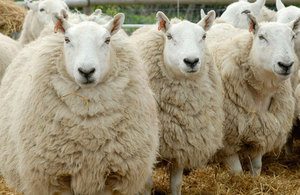Pregnant women advised to avoid animals that are giving birth
Pregnant women should avoid close contact with farmed animals that are giving birth, the Government advised today.

Pregnant women who come into close contact with sheep during lambing or other farm animals that are giving birth may risk their own health, and that of their unborn child, from infections that such animals can carry.
Therefore the Department of Health, Public Health England, the Department for Environment, Food and Rural Affairs, and the Health and Safety Executive have issued annual advice for a number of years that women who are or may be pregnant should avoid animals who are giving, or who have recently given, birth.
Although the number of human pregnancies affected by contact with an infected animal is extremely small, it is important that pregnant women are aware of the potential risks and take appropriate precautions. These risks are not only associated with sheep, nor confined only to the spring (when the majority of lambs are born). Cattle and goats that have recently given birth can also carry similar infections.
To avoid the possible risk of infection, pregnant women should:
-
not help ewes to lamb, or to provide assistance with a cow that is calving or a nanny goat that is kidding;
-
avoid contact with aborted or new-born lambs, calves or kids or with the afterbirth, birthing fluids or materials (e.g. bedding) contaminated by such birth products;
-
avoid handling (including washing) clothing, boots or any materials that may have come into contact with animals that have recently given birth, their young or afterbirths. Potentially contaminated clothing will be safe to handle after being washed on a hot cycle;
-
ensure contacts or partners who have attended lambing ewes or other animals giving birth take appropriate health and hygiene precautions, including the wearing of personal protective equipment and clothing and adequate washing to remove any potential contamination.
Pregnant women should seek medical advice if they experience fever or influenza-like symptoms, or if concerned that they could have acquired infection from a farm environment.
Farmers have a responsibility to minimise the risks to pregnant women, including members of their family, the public and professional staff visiting farms.
Notes
-
Farmers should consult their veterinary surgeon about suitable vaccination programmes and any other disease control measures in sheep, cattle and goats.
-
The Control of Substances Hazardous to Health (COSHH) Regulations 2002 require employers and the self-employed to assess risks to health from harmful substances, including micro-organisms, and to take steps to prevent or control those risks, and The Management of Health and Safety at Work Regulations 1999 require employers and the self employed to further assess any risks which affect pregnant women.
-
Further information on zoonoses and appropriate control measures can be found on the HSE website.This includes the HSE Agriculture Information sheet 2 - Common Zoonoses in Agriculture and the 1997 publication Infection risks to new and expectant mothers in the workplace - a guide for employers, by the Advisory Committee on Dangerous Pathogens (ref: ISBN 0-7176-1360-7)
-
Further information on the infection risks to pregnant women from cattle, sheep and goats that have given birth is available on the Defra website and the PHE website